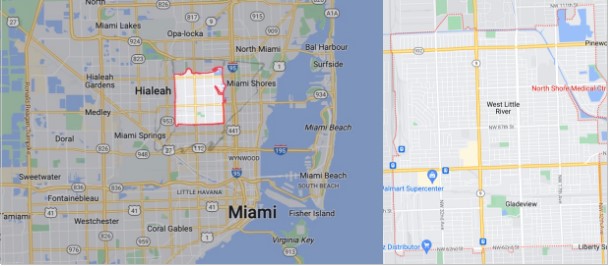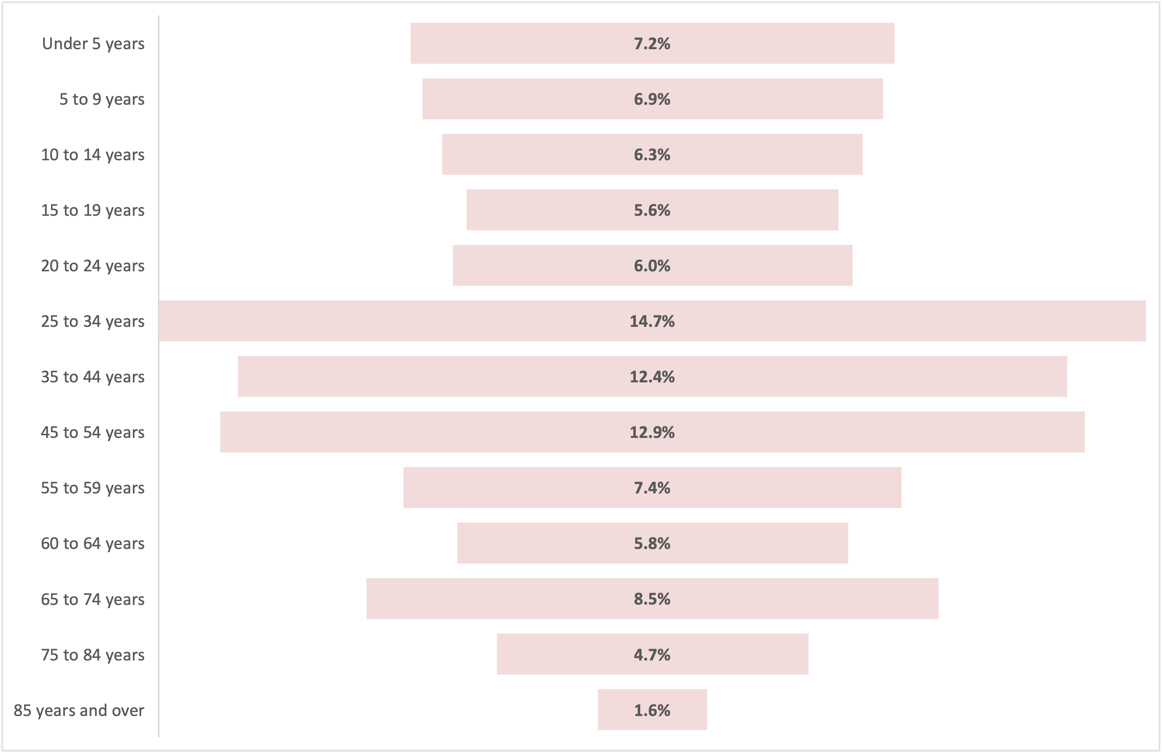Community Description
The community of interest is Miami, FL 33147, USA, located in southeast Florida (Figure 1). This paper aims to assess community health needs based on a holistic approach (Eklund et al., 2019). This means that environmental, socio-demographic, and urban factors are assessed in addition to the clinical health parameter.

People
The community has a population of 46,363 as of 2021, of which 48.7% are males, and 51.3% are females (US Census, 2022). The predominant ethnic groups are Black (51.5%), Hispanic (44.5%), and White (2.6%). The median age is 38 years, with the age pyramid (Figure 2) describing a stationary change with a moderate birth rate but an early age of elderly mortality. The median income of residents was nearly $40,000, but about 1/5 of the population lives below the poverty line. There were more married couples (27.7%) than cohabiting (8.1%) or single (24.2%), but cumulatively fewer than widowed or divorced (64.1%). People over 25 had the highest representation of college graduates (76%). During street observation, most people represented students (approximately 32%), tourists (approximately 17%), or parents with children (approximately 19%). Various ethnic and religious groups were represented with apparent signs of confessional identity (hijab, kippah), but most people had no distinctive religious features.

Environment
There are several small public parks, namely Arthur Woodard Park, Gwen Cherry Park, Arcola Lakes Park, and Little River Park, and tiny park areas used primarily as play areas or dog walking spaces. These areas look clean but, with few exceptions, contain outdated equipment or fencing. During street observation, these park areas were found to have small amounts of pollution and a few overflowing trash cans. Some owners were walking their dogs without muzzles, which may have endangered the safety of children (Kienesberger et al., 2022). Otherwise, Gwen Cherry Park and Arcola Lakes Park have plenty of sports equipment and areas that locals actively use to play soccer, tennis, or volleyball, as well as several grilling areas.
All the parks are actively used, and there was no period during street observation when the parks were empty. The spaces are well-lit, with streetlights and garlands owned by local businesses. The community has several major streets with permitted bicycle traffic, totaling about 5-6 miles. The air in public spaces is clean and sufficiently distant from major roadways, giving residents a break from the noise, especially in Arthur Woodard Park. A few police cars were seen patrolling nearby areas, so there does not seem to be a problem with violence except for dogs without muzzles.
Social Systems
There are several health centers, with Doctors Medical Centers being the largest, with no specialty centers for elderly clients. There are only a few pharmacies (the largest being Jenny’s Pharmacy & Discount and Walgreens Pharmacy), several supermarkets, and many food outlets. Bus stops are only on two parallel roads (NW 27th and NW 32nd Avens), so the community predominantly uses cars. Many educational institutions exist, but no university education institutions exist. The region has a Northside Police Station, poorly trusted by the community, and one fire station.
Analysis
Strengths
The major strengths are the presence of ethnic and cultural diversity, an educated population, and public spaces where residents can recreate in a generally uncontaminated environment and engage in sports.
Major Needs
The priority needs are constructing a center for elderly care and improved transportation interchanges that allow residents to travel more efficiently. The aging population must be able to receive quality clinical services, including access to them by public transportation. Improving access to health care among the elderly and quality of life through transportation accessibility and reducing automobile pollution are Healthy People (HP) 2030 goals to support the program (US DHHS, n.d.). Thus, the strategy is expected to create a better urban environment and improve quality of life.
Recommendations
The Health Foundation of South Florida (HFSF) is a charitable organization dedicated to closing the healthcare gap. HFSF has the advantage of focusing on vulnerable groups; in 33147, more than 21% of the population is below the poverty line (HFSF, n.d. – a; US Census, 2022). HFSF’s vision is “all South Floridians have an equal opportunity to achieve optimal health and well-being” — this aligns with the HP 2030 goals, which include improving access to health care and caring for vulnerable groups (HFSF, n.d. – a, para. 2; US DHHS, n.d.). One recent example of HFSF activities includes a $2 million grant to local universities to examine the determinants of poor access to medicine and to remove barriers (HFSF, n.d. – b). Thus, HFSF’s philanthropic efforts are aligned with the HP 2030 goals and aim to improve the quality of life.
Summary
The community is developed and balanced, but the key weaknesses are poverty, low transport accessibility, and insufficient clinical elderly care. Critical needs are the creation of a care center for them and improving transportation accessibility, such as the addition of bus routes. Ignoring these needs creates a deficit in access to key social institutions and impedes preventive activities for the aging population. An appropriate solution may include nurses’ need to make regular routine rounds of elderly patients at home.
Reflection
The street observation allowed me to identify previously unnoticed patterns and become more sensitive. I understood how complex a particular region is, and it became clear how difficult it is to manage larger agglomerations. The role of nurses will continue to expand away from the traditional assisting of physicians, so the responsibility of nurses will become significantly greater. Nurses must continually analyze and assess community risks to take the best steps to improve clinical access among all groups, and in this scenario, the solution was home visits to elderly patients. To get involved in civic life, as a nurse, I would initiate community observation programs, survey patients, participate in political lobbying for laws that improve healthcare options, and create a training group for volunteers to help the healthcare institution and patients in need.
References
Eklund, J. H., Holmström, I. K., Kumlin, T., Kaminsky, E., Skoglund, K., Höglander, J., & Meranius, M. S. (2019). “Same same or different?” A review of reviews of person-centered and patient-centered care. Patient Education and Counseling, 102(1), 3-11. Web.
HFSF. (n.d. – a). Mission & vision. Health Foundation of South Florida. Web.
HFSF. (n.d. – b). Health Foundation of South Florida invests $2 million in Florida universities to advance health equity in underserved communities. Health Foundation of South Florida. Web.
Kienesberger, B., Arneitz, C., Wolfschluckner, V., Flucher, C., Spitzer, P., Singer, G., & Schalamon, J. (2022). Child safety programs for primary school children decrease the injury severity of dog bites. European Journal of Pediatrics, 181, 1-6. Web.
US Census. (2022). American community survey | tables. United States Census Bureau. Web.
US DHHS. (n.d.). Health care access and quality. Healthy People 2030. Web.